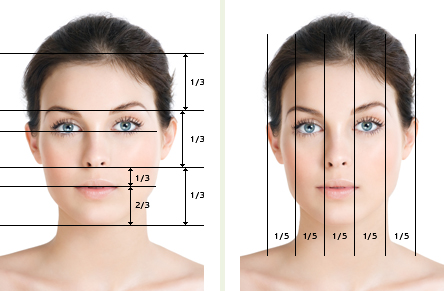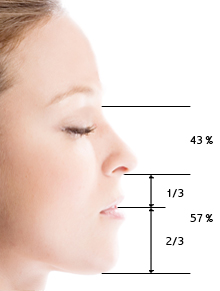AESTHETIC SURGERY
Aesthetic Rhinoplasty
Aesthetic rhinoplasty can correct non-health-related deformities of the external nose which the patient would like to have changed

“Aquiline nose”, “upturned nose”, “large nose”
Aesthetic corrective surgery of the nose is considered a purely elective procedure, so neither statutory nor private health insurance providers will cover the costs of such treatment.
 Examination and Diagnostic Assessment
Examination and Diagnostic AssessmentDiagnostic assessment consists of a careful clinical examination, in which the surgeon evaluates the patient’s skin quality and the rigidity of the nasal bones and cartilage. An inspection of the internal nose is also part of the initial examination, as is careful photo documentation.
The findings are analyzed in relation to the specifications of what is considered an aesthetically pleasing facial profile.

The proportions of a well balanced face

The proportions of a well balanced face
After the surgeon has familiarized himself with the patient’s individual desires, he can reconcile these with the aforementioned specifications to determine which surgical procedures would be appropriate.
 What are the surgical techniques used?
What are the surgical techniques used?There are two techniques, distinguished by the location of the incision:
1. “Closed Technique”
The nasal skeleton is accessed exclusively through the interior of the nose, leaving no visible scars. This technique is used for modifications of a smaller scale.
2. “Open Technique“
The skin is completely detached from the nose, with the incision at the bridge, so that the surgeon can directly see the shape of the nose as he modifies it. The advantage of direct sight is important when significantly altering the shape of the nose. The remaining scar at the bridge of the nose is unnoticeable when the wound is allowed to heal properly.
If additional material is required to build up the bone or cartilage of the nasal skeleton, this can be harvested from the patient’s own body, either from the nasal septum or from the concha of the ear.

Procedure: rhinoplasty
 What is the operation like?
What is the operation like?The operation is usually conducted under general anesthesia. Depending on the scope of the operation, it may be conducted on an outpatient basis or during a short hospital stay. The new shape of the nose will be reinforced from the outside by a cast and from within by nasal tamponades.
 What happens after the operation?
What happens after the operation?The postoperative phase is most notably marked by obstructed breathing through the nose, which returns to normal after a few weeks. Patients who tend to bruise easily may experience a blue discoloration of the skin under the eyes. Removal of the cast takes place one week after the operation. Physically strenuous tasks and sports activities should be avoided for the first four weeks of recovery.
 Could there be any complications?
Could there be any complications?The risk of postoperative hemorrhage is minimized by the compression of the nasal tamponades. In some cases, the nose may settle or shift unfavorably after surgery due to the tendency of the tissue to return to its preoperative shape. A simple corrective procedure can be conducted once the wound has healed completely, generally six weeks after the initial surgery, at no further cost to the patient.
Berlin 2010, Dr. med. Dr. med. dent. Herbert Kindermann